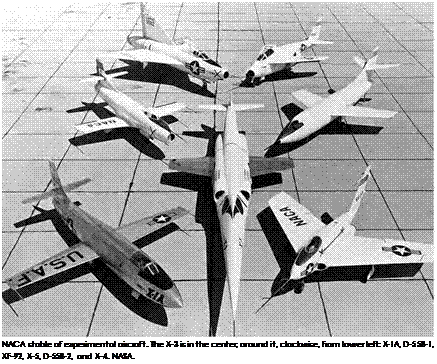Gathering the Data for Supersonic Airplane Design
![]() NACA supersonic research after 1947 concentrated on the practical problems of designing supersonic airplanes. Basic transonic and low supersonic test data were collected in a series of experimental aircraft that did not suffer from the necessary compromises of operational military aircraft. The test programs were generally joint efforts with the Air Force and/or Navy, which needed the data in order to make reasonable decisions for future aircraft. The X-1 (USAF) and D-558-1 and D-558-2 (Navy) gathered research data on aerodynamics and stability and control in the transonic regime as well as flight Mach numbers to slightly above 2. The D-558-1 was a turbojet vehicle with a straight wing; as a result, although it had longer mission duration, it could not achieve supersonic flight and instead concentrated on the transonic regime. For supersonic flights, the research vehicles generally used rocket engines, with their corresponding short-duration data test points. Other experimental vehicles used configurations that were thought to be candidates for practical supersonic flight. The D-558-2 used a swept wing and was able to achieve Mach 2 on rocket power. The XF-92A explored the pure delta wing high-speed shape, the X-4 explored a swept wing that dispensed with horizontal tail surfaces, the X-5 configuration had a swept wing that could vary its sweep in flight, and the X-3 explored a futuristic shape with a long fuselage with a high fineness ratio combined with very low aspect ratio wings and a double-diamond cross section that was intended to reduce shock wave drag at supersonic speeds. The Bell X-2 was a NACA-USAF-sponsored rocket research aircraft with a swept wing intended to achieve Mach 3 flight.[1056]
NACA supersonic research after 1947 concentrated on the practical problems of designing supersonic airplanes. Basic transonic and low supersonic test data were collected in a series of experimental aircraft that did not suffer from the necessary compromises of operational military aircraft. The test programs were generally joint efforts with the Air Force and/or Navy, which needed the data in order to make reasonable decisions for future aircraft. The X-1 (USAF) and D-558-1 and D-558-2 (Navy) gathered research data on aerodynamics and stability and control in the transonic regime as well as flight Mach numbers to slightly above 2. The D-558-1 was a turbojet vehicle with a straight wing; as a result, although it had longer mission duration, it could not achieve supersonic flight and instead concentrated on the transonic regime. For supersonic flights, the research vehicles generally used rocket engines, with their corresponding short-duration data test points. Other experimental vehicles used configurations that were thought to be candidates for practical supersonic flight. The D-558-2 used a swept wing and was able to achieve Mach 2 on rocket power. The XF-92A explored the pure delta wing high-speed shape, the X-4 explored a swept wing that dispensed with horizontal tail surfaces, the X-5 configuration had a swept wing that could vary its sweep in flight, and the X-3 explored a futuristic shape with a long fuselage with a high fineness ratio combined with very low aspect ratio wings and a double-diamond cross section that was intended to reduce shock wave drag at supersonic speeds. The Bell X-2 was a NACA-USAF-sponsored rocket research aircraft with a swept wing intended to achieve Mach 3 flight.[1056]
Valuable basic data were collected during these test programs applicable to development of practical supersonic aircraft, but sustained supersonic flight was not possible. The limited-thrust turbojets of the era limited the speeds of the aircraft to the transonic regime. The X-3 was intended to explore flight at Mach 2 and above, but its interim engines made that impossible; in a dive with afterburners, it could only reach Mach 1.2. The XF-92A delta wing showed promise for supersonic
 |
|
designs but could not go supersonic in level flight.[1057] This was unfortunate, as the delta winged F-102—built by Convair, which also manufactured the XF-92—was unable to achieve its supersonic design speeds and required an extensive redesign. This redesign included the "area rule” concept developed by the NACA’s Richard Whitcomb.[1058] The area rule principle, published in 1952, required a smooth variation in an aircraft’s cross-section profile from nose to tail to minimize high drag normal shock wave formation, at which the profile has discontinuities. Avoiding the discontinuities, notably where the wing joined the fuselage, resulted in the characteristic "Coke bottle” or "wasp waist” fuselage adjacent to the wing. This was noticeable in supersonic fighter designs of the late 1950s, which still suffered from engines of limited thrust, afterburner being necessary even for low supersonic flight with the resultant
short range and limited duration. The rocket-powered swept wing X-2 Mach 3 test program was not productive, with only one flight to Mach 3, ending in loss of the aircraft and its pilot, Capt. Milburn "Mel” Apt.[1059]










